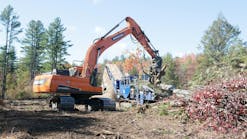There were generations who built the infrastructure of this nation. My father always called them the backbone of the country. These were the generations born out of the Great Depression and World War II. These were the populations that answered the call to stand up as a global superpower.
And there were the generations that followed. The ones that accomplished some of their own history, but used, abused, and neglected the roads, highways, bridges, pipes, subways, and electrical grid. Now we’re past the breaking point. All that infrastructure needs to be fixed or rebuilt, which brings up a historic opportunity for new generations.
There were generations who built the infrastructure of this nation. My father always called them the backbone of the country. These were the generations born out of the Great Depression and World War II. These were the populations that answered the call to stand up as a global superpower. And there were the generations that followed. The ones that accomplished some of their own history, but used, abused, and neglected the roads, highways, bridges, pipes, subways, and electrical grid. Now we’re past the breaking point. All that infrastructure needs to be fixed or rebuilt, which brings up a historic opportunity for new generations. [text_ad] That means we will need millennials. Is this going to be a problem? Somewhere down the line, as we moved gleefully into an age of Internet startups and hedge fund managers, our nation’s desire to get our hands dirty and build wasn’t completely passed on to the younger generations. A report in Bloomberg.com titled “Millennials: Builders Are Desperate to Hire You” written by Patrick Clark suggests that we need to change our recruiting tactics. Here are a few excerpts:“When the builder Frank L. Blum Construction, based in Winston-Salem, N.C., was getting started in the 1920s, the company’s assets included an automobile, two concrete mixers, and a team of mules. One assumes the animals were paid in food. Today, Blum’s talent gets considerably more coddling. In recent years, the company has doubled down on its employee training program, fattened its benefit package, and started a mentoring program that has met at a bowling alley and a Dave & Buster’s arcade. The company has also invited clients, including a local hospital and a park for which it's building a public art installation, to talk to employees about why construction work matters. Those initiatives are an attempt by Blum's president, Mike Lancaster, to answer a question that resonates across the industry: Faced with an aging workforce, how can construction companies attract the young workers they need for the ongoing expansion? “The old days of hiring someone and sticking them on the job site and saying, ‘Go learn construction,’ that’s gone,” said Lancaster. “We have to show new talent that we will develop you, appreciate you, and engage you.”Clark also writes:
“It’s absolutely a challenge that the construction industry is going to have to face,” said Robert Dietz, an economist for the National Association of Home Builders. “Scarcity of labor has been a top challenge this year, and it’s not going away next year.” Present-day labor shortages and concerns about the aging workforce have led employers and trade groups to launch new programs to train workers, as well as marketing efforts to persuade young workers that they can build careers in construction. Tecta America, a commercial roofing firm in Rosemont, Ill., with 2,800 workers, is seeking certification from state labor departments across the U.S. for a new three-year apprenticeship program for field workers, and the company has a separate program to teach future supervisors skills such as finance and computer skills. Meanwhile, Tecta America has been promoting itself to students as a place where employees can work on environmentally sustainable projects such as green roofs. “We’re not just going into high schools but junior high,” said Nicole Eisenhardt, a human resource manager for the company. Trade groups, meanwhile, have marshaled resources in support of broader-based efforts. In 2013, the Foundation of the Wall & Ceiling Industry, a nonprofit in Falls Church, Va., published a report for its members that uses such phrases as "coddled" and "me-first" to describe young workers. The report recommended that hirers engage in social media recruiting and highlight the high-tech aspects of construction trades.Employers and trade groups have created new training and recruiting programs some of which would appeal to different segments of youth. Some are highlighting their environmental concerns to be more appealing. Others are touting higher pay. There’s advice circulating for employees to find new workers by taking to Facebook, or highlighting just how high tech the construction industry has become. Employers are also being told to create job opportunities that could take their young workers to supervisory roles. More from Clark:
“In 2010, AGC helped launch Go Build Alabama, a statewide marketing campaign arguing that construction offered better earning potential than the average American job and was accessible without expensive college degrees. The campaign, which featured reality TV host Mike Rowe speaking such catch phrases as "not all knowledge comes from college," was later replicated in Georgia. A third Go Build program got support from the Tennessee state legislature this year, although that program will likely tap a country music star as spokesman, according to Bill Young, executive vice president of the state's AGC chapter. How effective these campaigns will be remains an open question. Go Build Alabama helped boost applications to apprenticeship programs by 73 percent, according to the organization. Other programs may take longer to bear fruit. In April, the Home Builders Institute, the training arm of the NAHB, launched a program to train military personnel in construction trades to help them move back into the civilian world. The program's first cohort, stationed at the U.S. Army's Ft. Stewart, Ga., base, are building tiny houses for a nearby homeless population, said Dennis Torbett, a senior vice president at HBI. The program ticks some boxes for the pop-science of millennial recruiting but is years away from funneling a meaningful number of workers into the industry.”Clark says according to the Bureau of Labor Statistics, among US industries, construction is going to be adding jobs at the fastest rate, second to only healthcare. And if these hiring strategies don’t pan out, companies may have to take a more direct approach and simply offer higher salaries. Maybe at that point we’ll see if these millennials have some kind of backbone.
That means we will need millennials. Is this going to be a problem? Somewhere down the line, as we moved gleefully into an age of Internet startups and hedge fund managers, our nation’s desire to get our hands dirty and build wasn’t completely passed on to the younger generations.
A report in Bloomberg.com titled “Millennials: Builders Are Desperate to Hire You” written by Patrick Clark suggests that we need to change our recruiting tactics.
Here are a few excerpts:
“When the builder Frank L. Blum Construction, based in Winston-Salem, N.C., was getting started in the 1920s, the company’s assets included an automobile, two concrete mixers, and a team of mules. One assumes the animals were paid in food.
Today, Blum’s talent gets considerably more coddling. In recent years, the company has doubled down on its employee training program, fattened its benefit package, and started a mentoring program that has met at a bowling alley and a Dave & Buster’s arcade. The company has also invited clients, including a local hospital and a park for which it’s building a public art installation, to talk to employees about why construction work matters.
Those initiatives are an attempt by Blum’s president, Mike Lancaster, to answer a question that resonates across the industry: Faced with an aging workforce, how can construction companies attract the young workers they need for the ongoing expansion?
“The old days of hiring someone and sticking them on the job site and saying, ‘Go learn construction,’ that’s gone,” said Lancaster. “We have to show new talent that we will develop you, appreciate you, and engage you.”
Clark also writes:
“It’s absolutely a challenge that the construction industry is going to have to face,” said Robert Dietz, an economist for the National Association of Home Builders. “Scarcity of labor has been a top challenge this year, and it’s not going away next year.”
Present-day labor shortages and concerns about the aging workforce have led employers and trade groups to launch new programs to train workers, as well as marketing efforts to persuade young workers that they can build careers in construction. Tecta America, a commercial roofing firm in Rosemont, Ill., with 2,800 workers, is seeking certification from state labor departments across the U.S. for a new three-year apprenticeship program for field workers, and the company has a separate program to teach future supervisors skills such as finance and computer skills. Meanwhile, Tecta America has been promoting itself to students as a place where employees can work on environmentally sustainable projects such as green roofs. “We’re not just going into high schools but junior high,” said Nicole Eisenhardt, a human resource manager for the company.
Trade groups, meanwhile, have marshaled resources in support of broader-based efforts. In 2013, the Foundation of the Wall & Ceiling Industry, a nonprofit in Falls Church, Va., published a report for its members that uses such phrases as “coddled” and “me-first” to describe young workers. The report recommended that hirers engage in social media recruiting and highlight the high-tech aspects of construction trades.
Employers and trade groups have created new training and recruiting programs some of which would appeal to different segments of youth. Some are highlighting their environmental concerns to be more appealing. Others are touting higher pay. There’s advice circulating for employees to find new workers by taking to Facebook, or highlighting just how high tech the construction industry has become. Employers are also being told to create job opportunities that could take their young workers to supervisory roles.
More from Clark:
Clark says according to the Bureau of Labor Statistics, among US industries, construction is going to be adding jobs at the fastest rate, second to only healthcare. And if these hiring strategies don’t pan out, companies may have to take a more direct approach and simply offer higher salaries. Maybe at that point we’ll see if these millennials have some kind of backbone.“In 2010, AGC helped launch Go Build Alabama, a statewide marketing campaign arguing that construction offered better earning potential than the average American job and was accessible without expensive college degrees. The campaign, which featured reality TV host Mike Rowe speaking such catch phrases as “not all knowledge comes from college,” was later replicated in Georgia. A third Go Build program got support from the Tennessee state legislature this year, although that program will likely tap a country music star as spokesman, according to Bill Young, executive vice president of the state’s AGC chapter.
How effective these campaigns will be remains an open question. Go Build Alabama helped boost applications to apprenticeship programs by 73 percent, according to the organization. Other programs may take longer to bear fruit. In April, the Home Builders Institute, the training arm of the NAHB, launched a program to train military personnel in construction trades to help them move back into the civilian world. The program’s first cohort, stationed at the U.S. Army’s Ft. Stewart, Ga., base, are building tiny houses for a nearby homeless population, said Dennis Torbett, a senior vice president at HBI. The program ticks some boxes for the pop-science of millennial recruiting but is years away from funneling a meaningful number of workers into the industry.”




